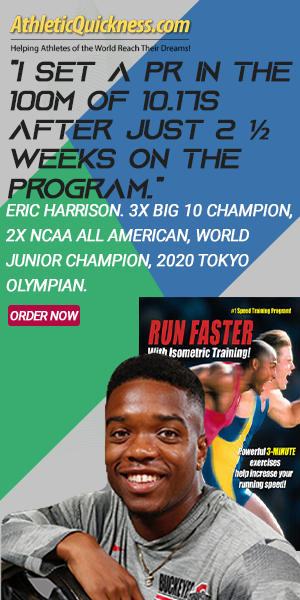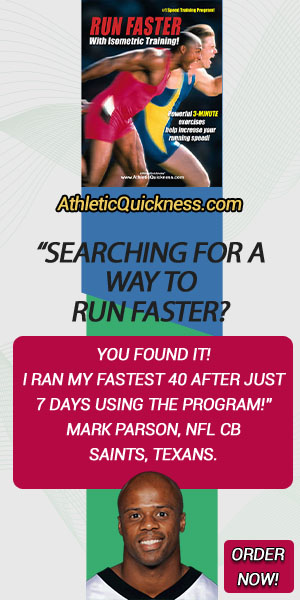What is the single most effective way to quickly increase speed of muscle contraction?
Answer: Isometric Training with the Resistance Band
The quickest way to get faster!
Every athlete with the desire to sprint faster and increase speed using conventional strength training methods will inevitably be faced with only two choices on how to do it.
Two Conventional Choices to Increase Speed
Choice 1) Increase the strength in their legs, thighs, hips and ankles while at the same time not gaining any significant body weight.
One of the consequences of heavy exercise is the addition of extra body weight in the form of muscle, fat or both is not always a benefit. Added weight in areas that are not relative to the skill simply becomes excess baggage.
More often than not, it won’t improve speed if you increase your lower body strength and, in the process, gain 10 pounds. This added weight is carried with you wherever you go, and if you think you are going to be able to run faster or even jump higher with what amounts to a 10 or 15 lb. weighted vest strapped around your chest, you are mistaken.
Choice 2) If your strength doesn’t increase significantly more in your legs to offset additional body weight, you will need to retain your current level of lower body strength and drop about 5 pounds.
Dropping weight may not seem like a big deal, but more often than not a loss of even 5 lbs. can significantly affect strength. Losing strength in your legs will make you slower, reduce vertical jumping ability; and, with regards to football, losing weight anywhere on your body may be a disadvantage for playing a collision sport.
So your athletic speed right now, whether you know it or not, will always be limited if all you ever do to try and increase speed is to consistently engage in excessive strength workouts.
Those exercises all have their place but your ability to get faster will be harder if while you are doing them, you are also not closely monitoring your strength and body weight ratio.
Is there another workout option?
There are other choices. One solution is to increase the contraction rate of your muscles … that is to make them contract faster.
Developing faster muscles involves the use of what is known as isometric contractions. Isometric contractions or isometric training is most often associated with weight training, where athletes typically use that strategy to get past sticking points in their lifts, most notably the bench press. But, isometric training with weights will not improve muscle contractions rates and therefore will not improve athletic speed and quickness!
Fortunately, there is another form of resistance that will have a much more dynamic effect on your muscle speed. And, that’s the resistance band.
Resistance bands have what is known as a hyper-elastic potential. This means that to stretch the band farther, more effort is needed. When used properly with an isometric training strategy, the resistance band becomes the ideal training device to quickly increase your speed.
Why the Resistance Band & Isometrics Give You Greater Speed
To break through your current level of speed, you need to start thinking outside the box with regards to your training.
You absolutely must find a way to stimulate your muscle fibers differently than the heavy training routines you’ve been doing. You need to start developing completely unique muscle contraction patterns within your muscles and exposing and then eliminating coordination issues with them. Otherwise you are going to continue to struggle trying to increase your speed.
The resistance band with an isometric training strategy is exactly the type of change in your routine that you are probably lacking and which is needed to accomplish your speed goals.
The resistance in the band is variable. This means any small changes in muscle length, that is, any slight movement or change of position in your muscle, while attempting to hold the band in a fixed position, will instantly affect the amount of resistance returned to the muscle.
This becomes especially noticeable when you put yourself in unique positions where your coordination is really being tested, while at the same time trying to hold an isometric contraction with a stretched resistance band. When doing this you will quickly see and experience the results in greater speed.
When your muscles enter a weakened and uncoordinated state while under variable levels of resistance, the muscle fibers become hyper-excited and develop new muscle contraction patterns that are needed to regain control. This is where you will find your athletic speed and performance starting to dramatically take off!
And because you are not forcing your muscles through the typical concentric and eccentric muscle contractions that stimulate muscle growth, you won’t gain any significant weight to offset these gains.
How to unleash a huge reservoir of untapped muscular energy!
Imagine if you knew how to precisely isolate all of the muscle groups within a specific athletic skill and trained them this way. What do you think would happen? You would become quicker and faster than you have ever been before.
The best part is that this doesn’t take weeks and weeks of 45 minute training sessions to accomplish. Speed training, as the name implies, should be fast. All of the speed training programs offered by AthleticQuickness.com take only 15 minutes or less per day.
So, if you are not using resistance bands, as the AthleticQuickness training programs teach to train specific muscle groups in your body, you have a huge reservoir of untapped muscular energy just waiting to be released and that will greatly and quickly increase your speed and quickness and improve your overall athletic performance.
Always glad to help,
Dr. Larry Van Such






